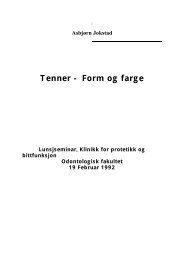Quality of dental restorations. FDI Commission Pro... - ResearchGate
Quality of dental restorations. FDI Commission Pro... - ResearchGate
Quality of dental restorations. FDI Commission Pro... - ResearchGate
Create successful ePaper yourself
Turn your PDF publications into a flip-book with our unique Google optimized e-Paper software.
132I inlays was lower than that for theother types <strong>of</strong> inlays, that is two-,three- and four-surface inlays.In study <strong>of</strong> over 1,544 amalgam<strong>restorations</strong>, 1,213 <strong>restorations</strong>remained after fifteen years. Itappeared as if the three-surface<strong>restorations</strong> had less favourableclinical outcomes compared totwo-surface <strong>restorations</strong> after 15years. Also, the provision <strong>of</strong> a 90 ocavosurface angle combined witha cavity wall finish reduced the risk<strong>of</strong> failure <strong>of</strong> amalgam <strong>restorations</strong>,compared to larger cavosurfaceangles 108,109 .Prati et al. 161 reported three-yeardata on 116 Class III and V polyacid-modifiedcomposite resin(‘compomer’) <strong>restorations</strong>. Theyfound no statistical differences withrespect to the USPHS criteriabetween the Class III and V <strong>restorations</strong>.In a cross-sectional appraisal <strong>of</strong>520 cast <strong>restorations</strong> in 56 patientsmade between one to 40 yearspreviously, the <strong>restorations</strong> includingmore than two surfaces wereassociated with less favourableoutcomes <strong>of</strong> quality and survival 162 .The outcome after three years<strong>of</strong> 446 <strong>restorations</strong> placed byone dentist and two <strong>dental</strong> nursesin 282 patients using the ARTtechnique was reported byPhantumvanit et al. 148 . The survivalwas lower for occlusal surface<strong>restorations</strong> compared to those inother surfaces.Friedl et al. 163,164 carried out across-sectional study in which 102dentists provided informationabout 3,375 composite resin and5,240 amalgam <strong>restorations</strong>. Thefailed <strong>restorations</strong> with foursurfaces had a lower median agecompared to the other types <strong>of</strong><strong>restorations</strong>.Jokstad et al. 165 reported on across-sectional study <strong>of</strong> 8,310<strong>restorations</strong> a marked associationbetween the age <strong>of</strong> the <strong>restorations</strong>and both the types and the size <strong>of</strong>the <strong>restorations</strong>.Data from a five-year prospectivestudy <strong>of</strong> the <strong>of</strong> 2,399 Class IIIand 1,093 Class V chemically-activatedanterior composite resin<strong>restorations</strong> assembled from 26general <strong>dental</strong> practices indicatedthat the overall probability <strong>of</strong>survival at five years was 10 percent higher for Class V <strong>restorations</strong>than for Class III <strong>restorations</strong> 142 .Smales and Gerke 166 evaluated700 anterior composite resin<strong>restorations</strong> over four years. Significantlymore failures occurred inClass IV and V preparations. Ofall failures, 81 per cent were fromClass V preparations, which mayreflect undue reliance on dentinebondingsystems for restorationretention in premolar non-cariouscervical lesions.Fritz et al. 167 reported the longtermoutcome <strong>of</strong> 2,717 cast<strong>restorations</strong> provided for 548patients during 1960–1989. Relativelyminor differences in the 15year survival were noted for foursizes <strong>of</strong> casts: single surface (65 percent), two-surface (60 per cent),three-surface (68 per cent) andinlays and onlays (70 per cent).Investigations published before1992 on the association betweenClass I and Class II cavity preparationsfor amalgam and <strong>restorations</strong>urvival has been reported in aprevious paper and will not bediscussed further 113 .Wilson and Norman 147 reportedfive-year findings <strong>of</strong> an 11-centretrial <strong>of</strong> a posterior composite resin.The findings were based on datacollected from 649 (68 per cent)<strong>of</strong> the 958 <strong>restorations</strong> originallyplaced. Chi-square analyses indicatedthat <strong>of</strong> the independentvariables investigated, size <strong>of</strong>restoration had the greatest associationwith clinical performance.In a study <strong>of</strong> 950 anteriorcomposite resin <strong>restorations</strong> oversixteen years there were significantlymore failures with the Class IVcompared to the Class III <strong>restorations</strong>153 .Bentley and Drake 168 reported astudy <strong>of</strong> 1,207 <strong>restorations</strong> placedby students in 70 patients. Singlesurface<strong>restorations</strong> lasted longerthan multi-surface <strong>restorations</strong>.Moreover, multisurface <strong>restorations</strong>including the occlusal surfacesurvived significantly longer thandid those including the facial orlingual surface.Material handling andproceduresFactors associated with materialhandling and procedures that mayaffect the incidence <strong>of</strong> margin failures<strong>of</strong> amalgam <strong>restorations</strong>include trituration time 106 , use <strong>of</strong>rubber dam 169,170 , condensationtechniques 171 , and the carving,burnishing and polishing techniques172 . The effect <strong>of</strong> burnishingamalgam restoration margins isdifficult to estimate, and nearlyimpossible to quantify since the‘surface treatment’ is influenced byfactors such as burnishing load,direction <strong>of</strong> the strokes, number<strong>of</strong> strokes, beginning time aftertrituration and the size <strong>of</strong> theburnisher 172 .To what extent cavity varnishesand their thicknesses promotemarginal failures is unknown. It isconceivable that some varnishesmay be incorporated into the amalgamalong the margin, and therebyreduce the strength in these areas.Thus, there is a theoretical possibilitythat the type or amount <strong>of</strong>varnish may be related to marginfracture. However, clinical data onsuch a relationship is sparse, andexisting data are not conclusive. Inone longitudinal study it wasrevealed that application <strong>of</strong> avarnish or silver suspension did notinfluence the risk <strong>of</strong> long-termrestoration failure 107–109 .Letzel et al. 171 assessed the type<strong>of</strong> condensation instrument, togetherwith patient and operator on theperformance <strong>of</strong> a single amalgamalloy over 2.5 years. The authorsreported an association betweenfailure and the patient and theoperator, but there were too fewfailures to establish an associationwith condensation instrument.However, the authors did not indicatehow ‘failure’ was assessed.International Dental Journal (2001) Vol. 51/No.3



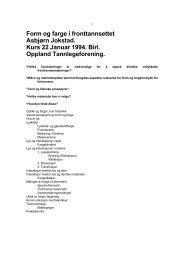
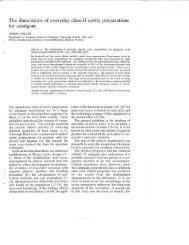
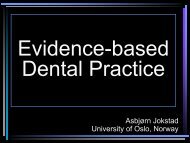
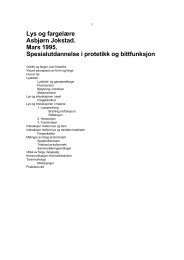
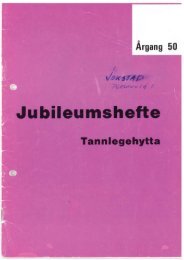
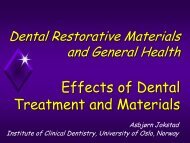
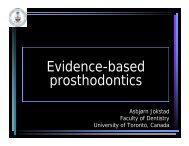

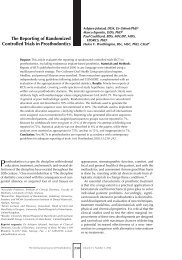
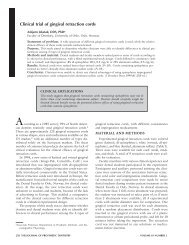

![[Sementer i fast protetikk] Scandinavian Society for Prosthetic](https://img.yumpu.com/18378889/1/190x245/sementer-i-fast-protetikk-scandinavian-society-for-prosthetic.jpg?quality=85)
